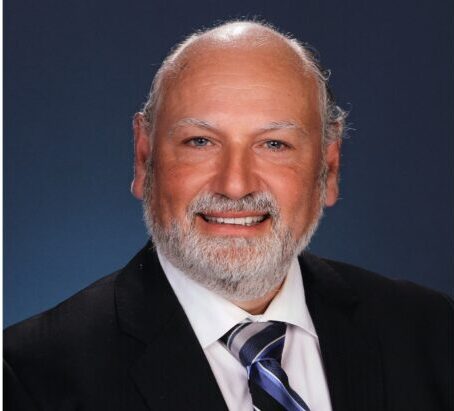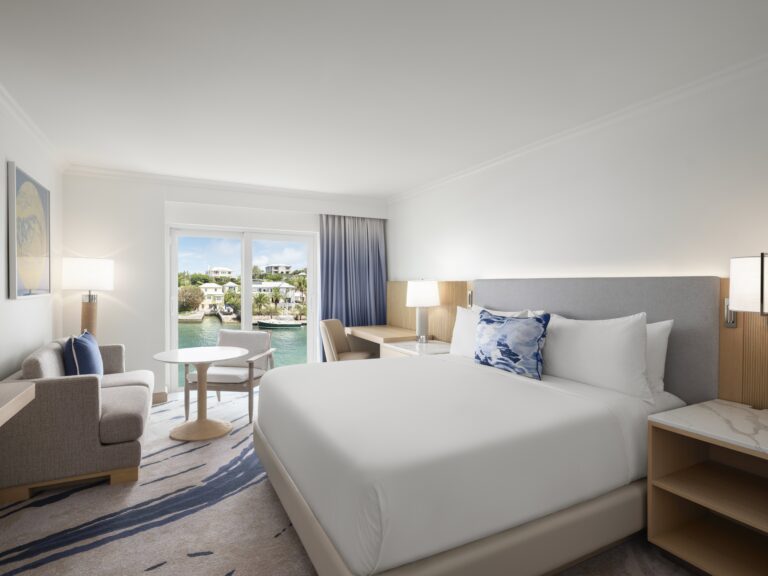(In photo: Luxury upgrade: a room in the refurbished Bermudiana Wing of the Hamilton Princess hotel – Photograph by Nhuri Bashir)
Covid-19 was supposed to sound the death knell for the commercial real estate sector, as remote working became entrenched in the pandemic’s aftermath. A few years later, it’s apparent from the cranes punctuating the Hamilton skyline that things have changed dramatically.
Huge investments in two new office buildings, and millions more ploughed into an overhaul of the Hamilton Princess and Beach Club, signal tangible confidence in the need for bricks and mortar, the preference of businesspeople to meet in person and the island’s future.
The impetus for much of this rejuvenation of the city comes from Bermuda’s thriving re/insurance sector, says Penny MacIntyre, a partner with Rego Sotheby’s International Realty.
Brookfield House, at 91 Front Street, being developed by global infrastructure giant Brookfield, is scheduled to be the first of the two major new office buildings to welcome tenants, with construction completion due in June 2026.
This nine-storey block, which also borders on Chancery Lane and Reid Street, is set to become the global headquarters for Brookfield Reinsurance and its Bermuda-domiciled affiliates. It will comprise 55,000 square feet of state-of-the-art commercial space and approximately 3,000 square feet of retail space.
Luscar Place, at 69 Pitts Bay, Road, will rise on the site of the demolished Belvedere Building in west Hamilton. A terraced, seven-storey structure, it will feature 130,000 square feet of office, retail and restaurant space. Completion is anticipated in April 2027.
The Green family, owners of the Hamilton Princess and Beach Club, who also developed Point House and Waterloo House in the same area of town, are also the investors behind Luscar.

Ms MacIntyre is the listing agent for both the Brookfield and Luscar properties. She has already seen strong pre-leasing interest from tenants eager for prime waterfront space.
Inquires were predominantly coming from re/insurance tenants for the office floors and retail or restaurant operators for the ground floor units, seeking spaces ranging from 4,000 square feet to more than 40,000 square feet, she said.
Demand for prime (Class A/A+) office space has climbed markedly over the past 18 months, with available inventory in the city’s central and business district area at its lowest level in more than two decades.
“As such, quality, ready-to-move-in spaces in prime locations do not sit on the market very long,” Ms MacIntyre said.
“As with all new construction, existing tenants in Bermuda looking for a potential upgrade tend to be the first wave of demand. But what’s different now, a few years after the pandemic, is the increased interest from US and European-based companies looking to set up more sizeable offices here.
“Those companies are getting their heads around the strength of our current commercial leasing rates, construction costs and residential housing needs of their staff.”
Some of the wave of new re/insurers to launch on the island over the past five years are seeking prime space, while more established, larger re/insurance firms need extra room to accommodate growing staffs.
“Because of the lack of prime turnkey-ready office spaces, longstanding office buildings continue to attract tenants who need space either immediately or in the next few months,” Ms MacIntyre said.
“Quality spaces in Class B properties vary widely in terms of location, sizes and views, but appeal to tenants who are price-sensitive, have timing constraints or no appetite for paying for a new build-out.”
Landlords with dated interiors are adapting by either upgrading lobbies and common areas or being more flexible on terms, she said.
Ms MacIntyre believes corporate confidence in Bermuda as a business jurisdiction has increased as a result of turbulent geopolitics and the US tariffs that have disrupted global trade and sparked financial market volatility.
Plans to build a new, five-storey office building on the site of the Bluck’s Building at 4 Front Street have also been submitted to the Planning Department, creating the potential for more prime space.
While international business is driving commercial construction, it is also a major constituent of Hamilton’s hospitality industry, as business visitors come in to shop for re/insurance, attend board meetings or go to conferences.
As the largest hotel in the city and the venue for many of those conferences and meetings, as well as corporate group business, the Hamilton Princess and Beach Club is a favourite with business clientele.
The Princess is close to completing a $15 million renovation of its Bermudiana Wing. All 113 rooms were stripped and upgraded. Following construction there are now 101 rooms, plus six one-bedroom suites that can be converted into two-bedroom suites. The work, overseen by general contractor Greymane Construction, started on November 18 last year. The first guests moved into refurbished rooms in April.
The work was Phase 4 of a multiphase overhaul, a massive, ongoing investment from the Green family to realise the hotel’s full potential. More than 100 tradesmen were on site each day and other local businesses involved included: Botelho Wood Architects, First Class Electrics, Efficiency Ltd, H&H Plumbing and Mechanical Ltd, Eminence Tile and Stone, Switchworx Ltd, Crisson Construction; and BUE (BAC Universal Electric).
The refurbished rooms are modern and elegant, with expanded balcony space offering views of Hamilton harbour or Pitt’s Bay. On a tour of the just-completed work, Tim Morrison, general manager of the hotel said the renovations would “elevate the space to the standard of luxury, comfort, and service that our guests have come to expect”.

Features include LED lighting, white oak wood furnishings in the living areas, granite features in the bathrooms with spa-like, deep soaking tubs in the suites. The 690 sq ft one-bedroom suite and 1,035 sq ft two-bedroom suites are at the far western end of the Bermudiana wing with spectacular water views to the west from oversized balconies.
Mr Morrison said the hotel had a mix of guests on business, on family holidays and “bleisure” guests who came to work and enjoy the island — and the renovated wing would appeal to all.
As business travel has rebounded strongly from the lows of the pandemic, the Hamilton Princess has made changes to strengthen its offerings to corporate visitors.
“We listened to our local corporate clients seeking intimate and boutique-type meetings spaces to fill their smaller meeting needs,” Mr Morrison said. “The result of that feedback was taking 14 guest rooms out of inventory on our Gold Floor in 2023 to add our Executive Meeting Suites in the summer of that same year.
“These four meeting suites were envisioned through the support and wish for continued enhancement by our hotel owners.”
Hamilton has traditionally been seen as a commercial centre, rather than a residential hub, but there is also a drive for more residential development in the city to help ease the housing crisis.
Ms MacIntyre said there was a need for more housing in Hamilton, particularly units available for rent.
“The challenge for developers is the ‘entry costs’, such as the cost to purchase a property to redevelop and construction costs,” she added. “With construction costs as much as 40 per cent more than before the pandemic, incentives are critical for developers especially if doing a speculative build project.”
These could include exemptions on import duty, reduced or waived payroll taxes for a period, and reduced land taxes, she suggested.
The hope must be that the IB-driven wave of development in Hamilton will add vibrancy to the city, build confidence in Bermuda’s future and generate knock-on benefits for the domestic economy.

